Report on India's Comparative Advantage in the Global Economy
VerifiedAdded on 2022/11/18
|5
|826
|228
Report
AI Summary
This report provides an analysis of India's comparative advantage in the global economy, focusing on the principles of comparative advantage as established by David Ricardo. It examines India's specialization in exporting manufactured goods and its shift towards high-value products. The report delves into the sources of India's comparative advantage, including natural resources, a large labor force, and investments in research and development, as well as challenges such as price competition and trade barriers. The role of the government in trade activities is also discussed. The report highlights India's demographic and educational advantages in international trade. The report provides a comprehensive overview of India's economic standing in the global market.
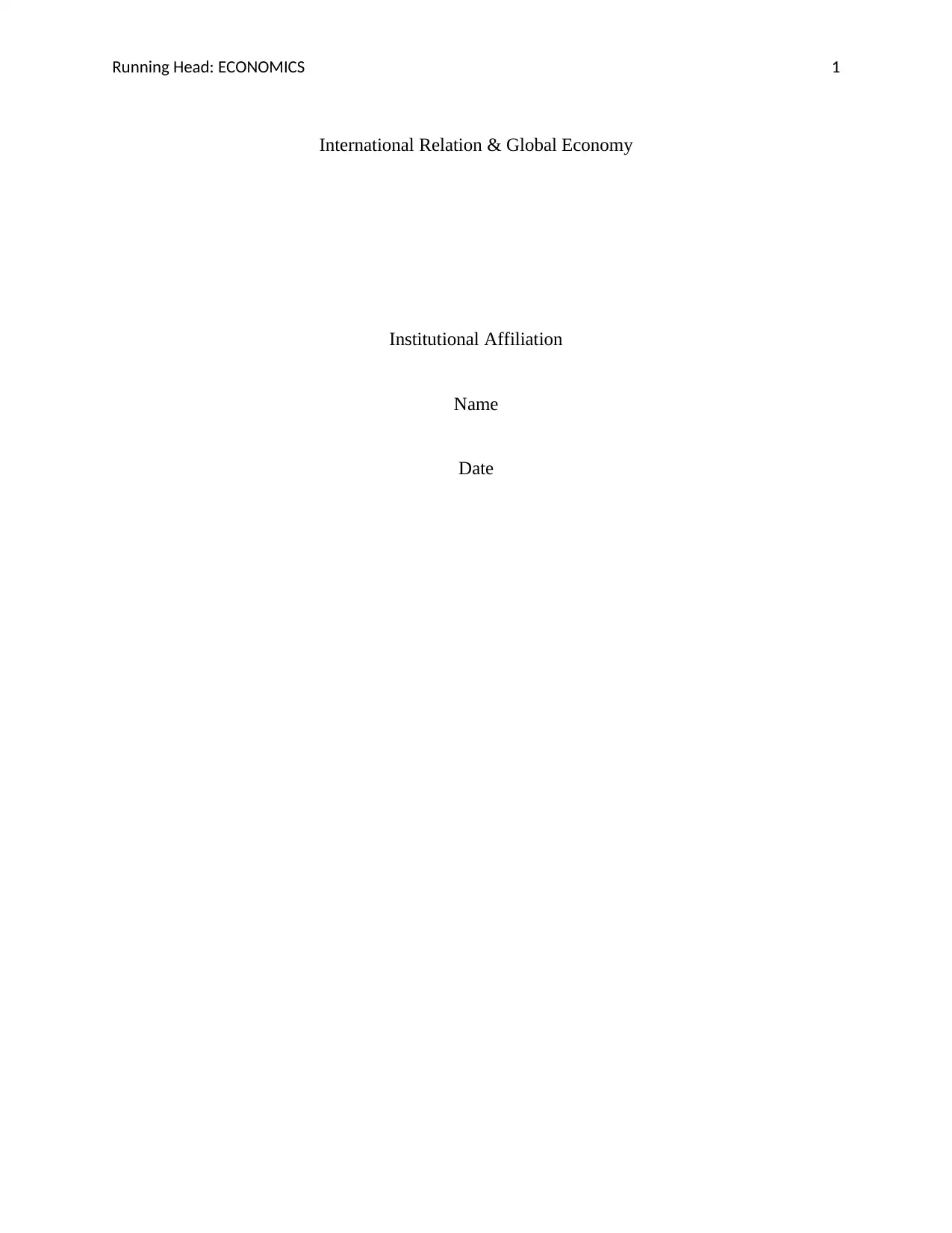
Running Head: ECONOMICS 1
International Relation & Global Economy
Institutional Affiliation
Name
Date
International Relation & Global Economy
Institutional Affiliation
Name
Date
Paraphrase This Document
Need a fresh take? Get an instant paraphrase of this document with our AI Paraphraser
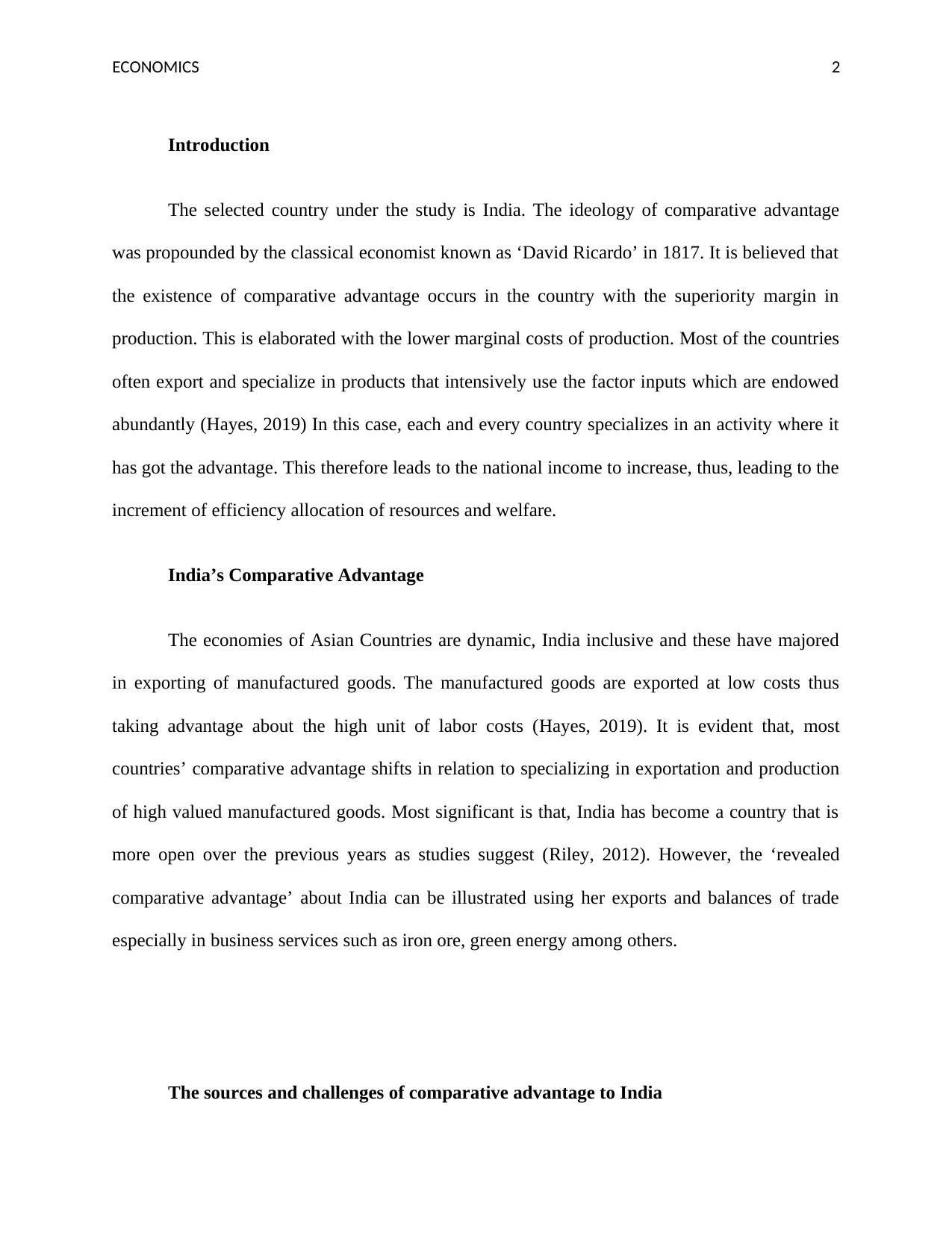
ECONOMICS 2
Introduction
The selected country under the study is India. The ideology of comparative advantage
was propounded by the classical economist known as ‘David Ricardo’ in 1817. It is believed that
the existence of comparative advantage occurs in the country with the superiority margin in
production. This is elaborated with the lower marginal costs of production. Most of the countries
often export and specialize in products that intensively use the factor inputs which are endowed
abundantly (Hayes, 2019) In this case, each and every country specializes in an activity where it
has got the advantage. This therefore leads to the national income to increase, thus, leading to the
increment of efficiency allocation of resources and welfare.
India’s Comparative Advantage
The economies of Asian Countries are dynamic, India inclusive and these have majored
in exporting of manufactured goods. The manufactured goods are exported at low costs thus
taking advantage about the high unit of labor costs (Hayes, 2019). It is evident that, most
countries’ comparative advantage shifts in relation to specializing in exportation and production
of high valued manufactured goods. Most significant is that, India has become a country that is
more open over the previous years as studies suggest (Riley, 2012). However, the ‘revealed
comparative advantage’ about India can be illustrated using her exports and balances of trade
especially in business services such as iron ore, green energy among others.
The sources and challenges of comparative advantage to India
Introduction
The selected country under the study is India. The ideology of comparative advantage
was propounded by the classical economist known as ‘David Ricardo’ in 1817. It is believed that
the existence of comparative advantage occurs in the country with the superiority margin in
production. This is elaborated with the lower marginal costs of production. Most of the countries
often export and specialize in products that intensively use the factor inputs which are endowed
abundantly (Hayes, 2019) In this case, each and every country specializes in an activity where it
has got the advantage. This therefore leads to the national income to increase, thus, leading to the
increment of efficiency allocation of resources and welfare.
India’s Comparative Advantage
The economies of Asian Countries are dynamic, India inclusive and these have majored
in exporting of manufactured goods. The manufactured goods are exported at low costs thus
taking advantage about the high unit of labor costs (Hayes, 2019). It is evident that, most
countries’ comparative advantage shifts in relation to specializing in exportation and production
of high valued manufactured goods. Most significant is that, India has become a country that is
more open over the previous years as studies suggest (Riley, 2012). However, the ‘revealed
comparative advantage’ about India can be illustrated using her exports and balances of trade
especially in business services such as iron ore, green energy among others.
The sources and challenges of comparative advantage to India
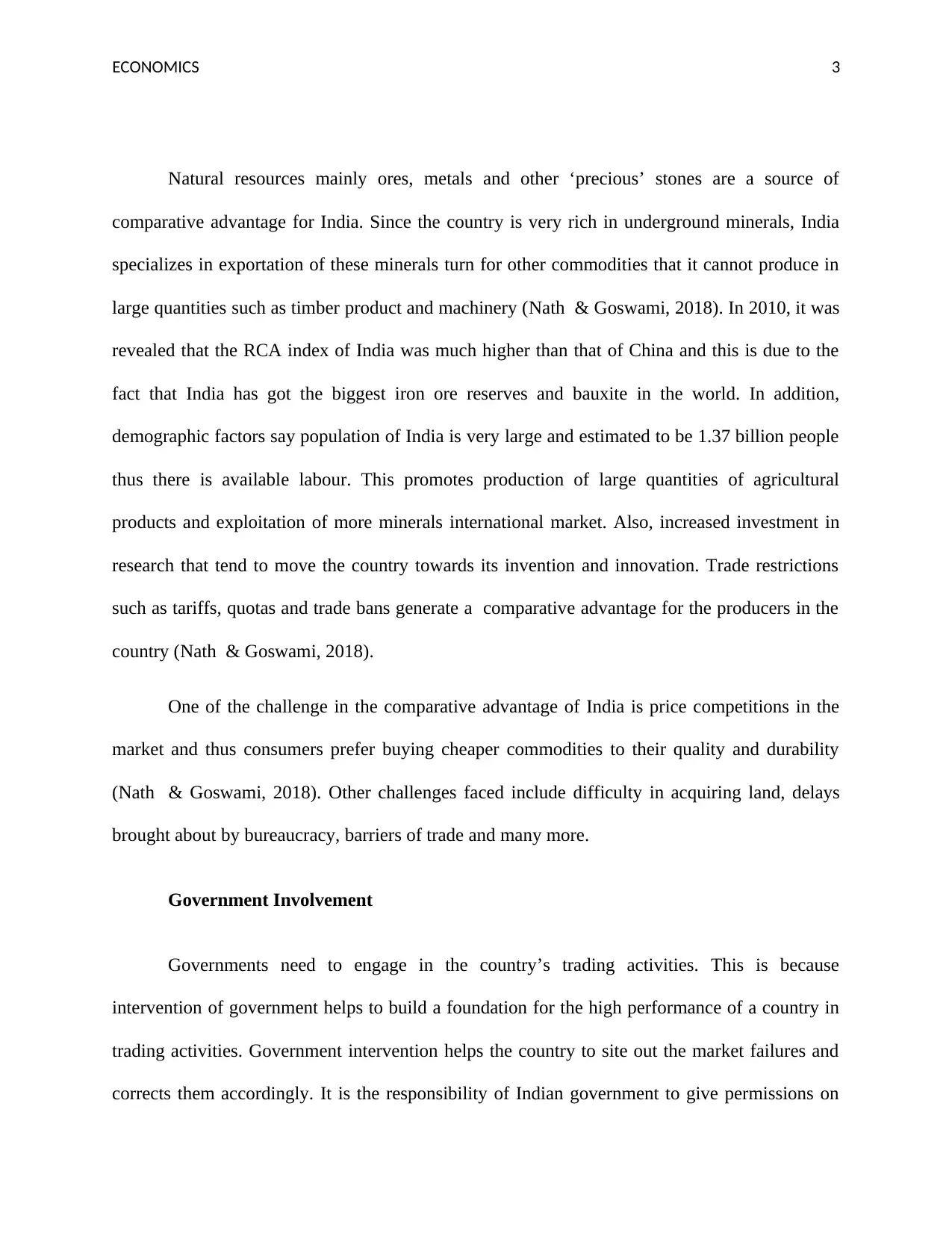
ECONOMICS 3
Natural resources mainly ores, metals and other ‘precious’ stones are a source of
comparative advantage for India. Since the country is very rich in underground minerals, India
specializes in exportation of these minerals turn for other commodities that it cannot produce in
large quantities such as timber product and machinery (Nath & Goswami, 2018). In 2010, it was
revealed that the RCA index of India was much higher than that of China and this is due to the
fact that India has got the biggest iron ore reserves and bauxite in the world. In addition,
demographic factors say population of India is very large and estimated to be 1.37 billion people
thus there is available labour. This promotes production of large quantities of agricultural
products and exploitation of more minerals international market. Also, increased investment in
research that tend to move the country towards its invention and innovation. Trade restrictions
such as tariffs, quotas and trade bans generate a comparative advantage for the producers in the
country (Nath & Goswami, 2018).
One of the challenge in the comparative advantage of India is price competitions in the
market and thus consumers prefer buying cheaper commodities to their quality and durability
(Nath & Goswami, 2018). Other challenges faced include difficulty in acquiring land, delays
brought about by bureaucracy, barriers of trade and many more.
Government Involvement
Governments need to engage in the country’s trading activities. This is because
intervention of government helps to build a foundation for the high performance of a country in
trading activities. Government intervention helps the country to site out the market failures and
corrects them accordingly. It is the responsibility of Indian government to give permissions on
Natural resources mainly ores, metals and other ‘precious’ stones are a source of
comparative advantage for India. Since the country is very rich in underground minerals, India
specializes in exportation of these minerals turn for other commodities that it cannot produce in
large quantities such as timber product and machinery (Nath & Goswami, 2018). In 2010, it was
revealed that the RCA index of India was much higher than that of China and this is due to the
fact that India has got the biggest iron ore reserves and bauxite in the world. In addition,
demographic factors say population of India is very large and estimated to be 1.37 billion people
thus there is available labour. This promotes production of large quantities of agricultural
products and exploitation of more minerals international market. Also, increased investment in
research that tend to move the country towards its invention and innovation. Trade restrictions
such as tariffs, quotas and trade bans generate a comparative advantage for the producers in the
country (Nath & Goswami, 2018).
One of the challenge in the comparative advantage of India is price competitions in the
market and thus consumers prefer buying cheaper commodities to their quality and durability
(Nath & Goswami, 2018). Other challenges faced include difficulty in acquiring land, delays
brought about by bureaucracy, barriers of trade and many more.
Government Involvement
Governments need to engage in the country’s trading activities. This is because
intervention of government helps to build a foundation for the high performance of a country in
trading activities. Government intervention helps the country to site out the market failures and
corrects them accordingly. It is the responsibility of Indian government to give permissions on
⊘ This is a preview!⊘
Do you want full access?
Subscribe today to unlock all pages.

Trusted by 1+ million students worldwide
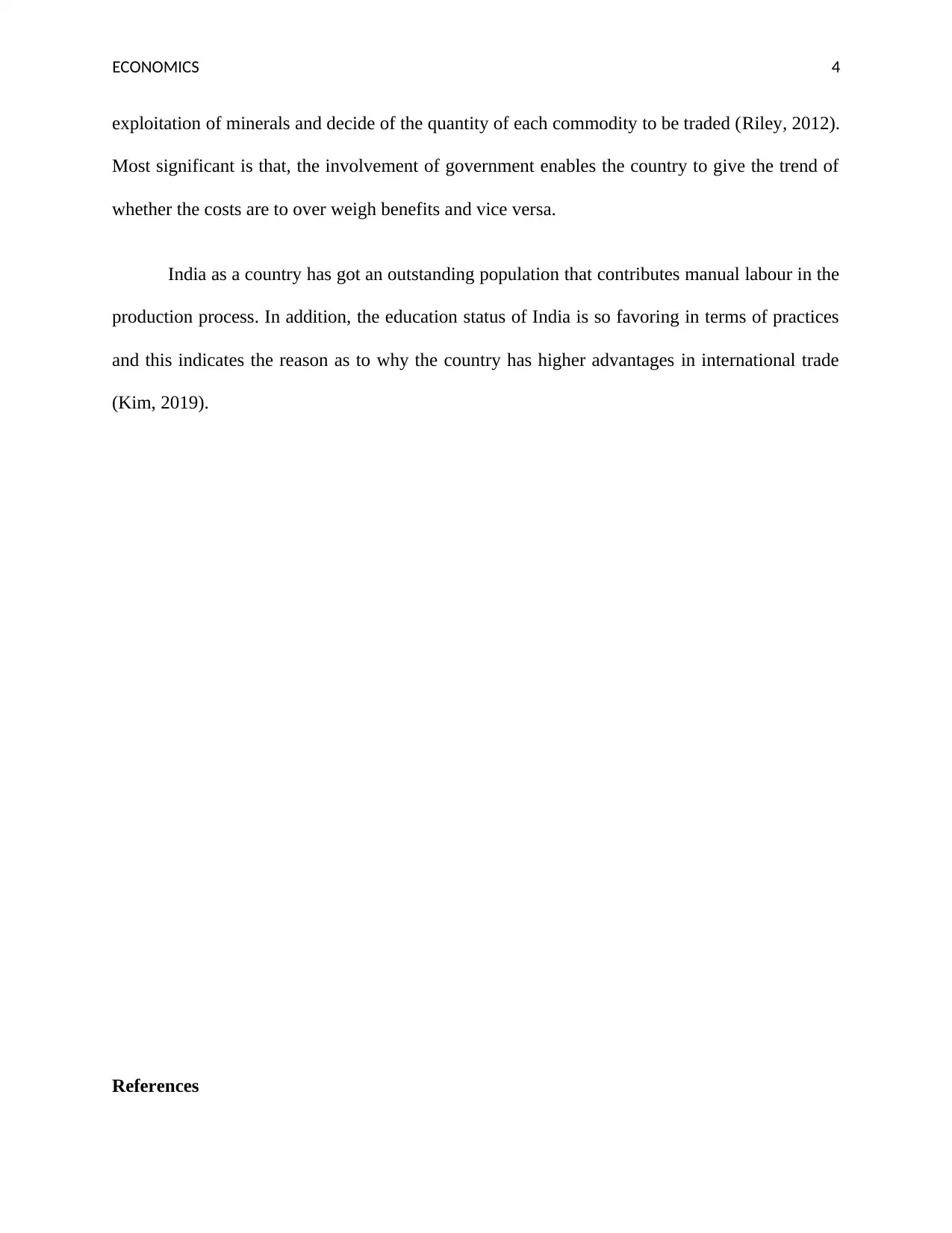
ECONOMICS 4
exploitation of minerals and decide of the quantity of each commodity to be traded (Riley, 2012).
Most significant is that, the involvement of government enables the country to give the trend of
whether the costs are to over weigh benefits and vice versa.
India as a country has got an outstanding population that contributes manual labour in the
production process. In addition, the education status of India is so favoring in terms of practices
and this indicates the reason as to why the country has higher advantages in international trade
(Kim, 2019).
References
exploitation of minerals and decide of the quantity of each commodity to be traded (Riley, 2012).
Most significant is that, the involvement of government enables the country to give the trend of
whether the costs are to over weigh benefits and vice versa.
India as a country has got an outstanding population that contributes manual labour in the
production process. In addition, the education status of India is so favoring in terms of practices
and this indicates the reason as to why the country has higher advantages in international trade
(Kim, 2019).
References
Paraphrase This Document
Need a fresh take? Get an instant paraphrase of this document with our AI Paraphraser
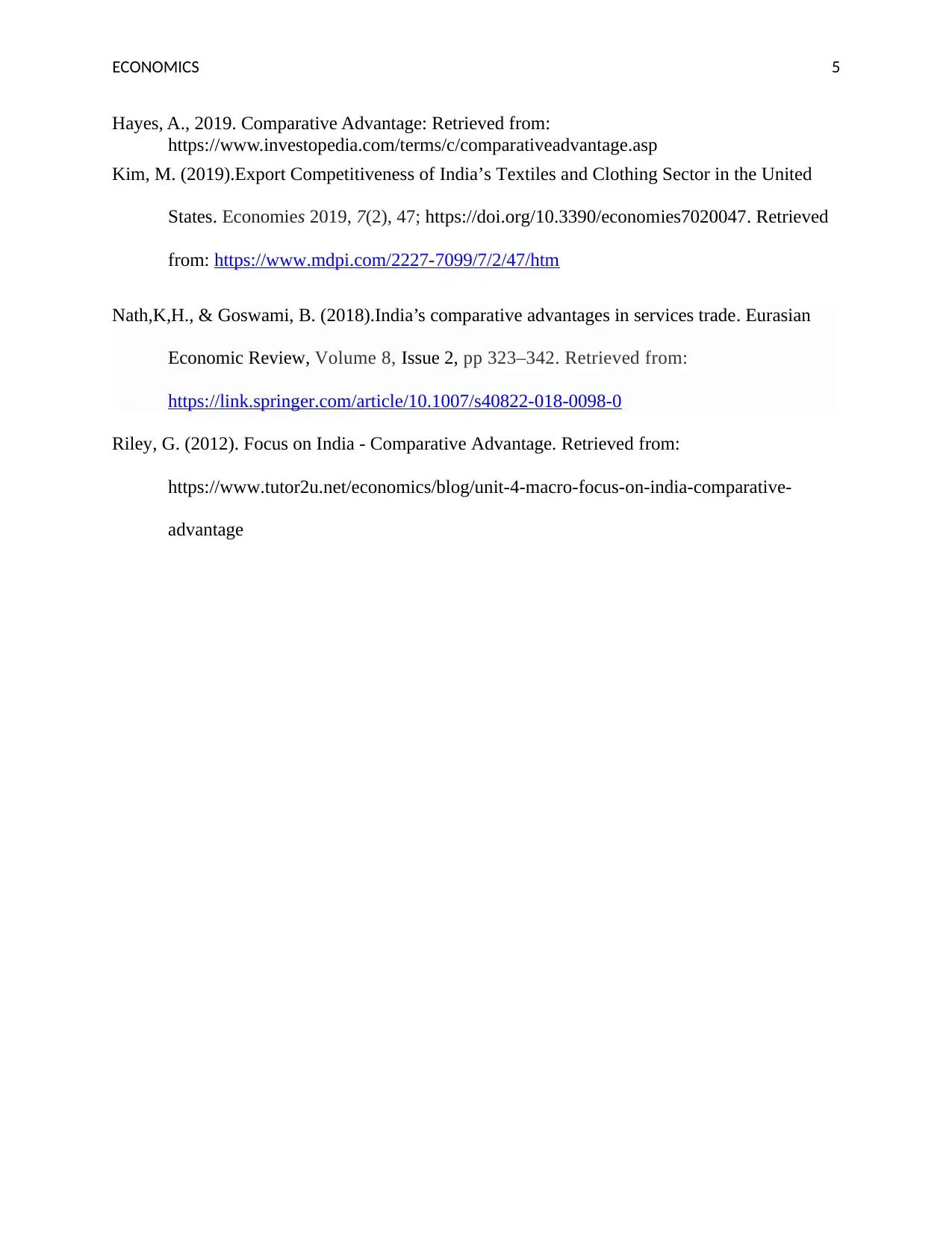
ECONOMICS 5
Hayes, A., 2019. Comparative Advantage: Retrieved from:
https://www.investopedia.com/terms/c/comparativeadvantage.asp
Kim, M. (2019).Export Competitiveness of India’s Textiles and Clothing Sector in the United
States. Economies 2019, 7(2), 47; https://doi.org/10.3390/economies7020047. Retrieved
from: https://www.mdpi.com/2227-7099/7/2/47/htm
Nath,K,H., & Goswami, B. (2018).India’s comparative advantages in services trade. Eurasian
Economic Review, Volume 8, Issue 2, pp 323–342. Retrieved from:
https://link.springer.com/article/10.1007/s40822-018-0098-0
Riley, G. (2012). Focus on India - Comparative Advantage. Retrieved from:
https://www.tutor2u.net/economics/blog/unit-4-macro-focus-on-india-comparative-
advantage
Hayes, A., 2019. Comparative Advantage: Retrieved from:
https://www.investopedia.com/terms/c/comparativeadvantage.asp
Kim, M. (2019).Export Competitiveness of India’s Textiles and Clothing Sector in the United
States. Economies 2019, 7(2), 47; https://doi.org/10.3390/economies7020047. Retrieved
from: https://www.mdpi.com/2227-7099/7/2/47/htm
Nath,K,H., & Goswami, B. (2018).India’s comparative advantages in services trade. Eurasian
Economic Review, Volume 8, Issue 2, pp 323–342. Retrieved from:
https://link.springer.com/article/10.1007/s40822-018-0098-0
Riley, G. (2012). Focus on India - Comparative Advantage. Retrieved from:
https://www.tutor2u.net/economics/blog/unit-4-macro-focus-on-india-comparative-
advantage
1 out of 5
Related Documents
Your All-in-One AI-Powered Toolkit for Academic Success.
+13062052269
info@desklib.com
Available 24*7 on WhatsApp / Email
![[object Object]](/_next/static/media/star-bottom.7253800d.svg)
Unlock your academic potential
Copyright © 2020–2025 A2Z Services. All Rights Reserved. Developed and managed by ZUCOL.




